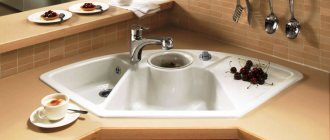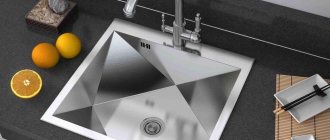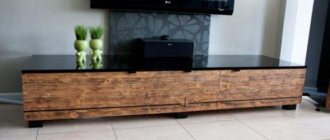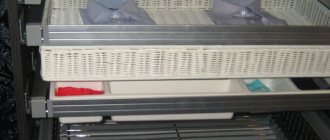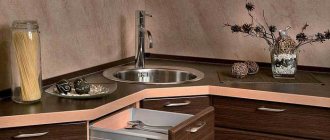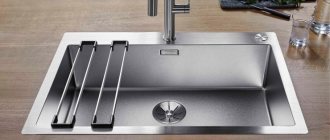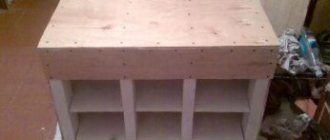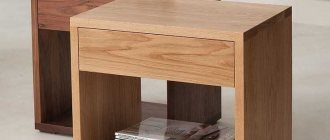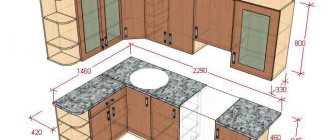Furniture in the kitchen is not only a functional element, but also an important component of the entire interior. If you do it yourself, this will help you significantly save on the services of a designer, manufacturer and installer, and will also allow you to show your creativity.
You can make a cabinet for a kitchen sink with your own hands from scrap materials, choosing any shape of the product and its filling capacity. It is easy to install kitchen appliances or a drinking water tank inside it, and you can also use it as additional storage space for kitchen utensils. It is important to take all these nuances into account when choosing a design and drawing up a sketch. Read on to learn about the step-by-step production of a kitchen sink cabinet.
Choosing a sink - type, shape, material
The choice of size and shape of the kitchen sink directly depends on the area of the kitchen. All sinks are divided into 3 types:
- round;
- square;
- modified previous options (oval, rectangular, with beveled corners, etc.).
The most popular are round products. There are the following types of sinks:
- With one bowl, which can be round or square. The first one is more spacious and suitable for small kitchens, therefore it is more common.
- With several bowls. Installed if there is free space in the kitchen. The tap is placed between the bowls or at an angle to them.
- With two bowls of different sizes. The smaller part of the sink is used for washing fruits, vegetables or defrosting food.
- Corner with several bowls.
- With additional work surface. The space is primarily used for drying clean dishes. Some sinks have holes for draining water. Sinks have one or more bowls.
There are different volumes of bowls on the market, but you should not choose too small. When the tap is running, splashes will fly out of the sink. Shells are made from the following materials:
- stainless steel;
- ceramics;
- artificial stone, which is divided into 2 types:
- acrylic;
- agglomerate.
- wood or stone.
The most common material is stainless steel. Nickel and chromium, which are included in the composition, contribute to a long service life without loss of appearance. Sinks can have a glossy or matte surface, ornament or texture. You can make a cabinet under any kitchen sink with your own hands. Making the item yourself is especially suitable in the case of non-standard shapes or sizes of the sink.
If the choice of product shape is determined by the taste of the owners, then the number of bowls is always dictated by the size of the kitchen. You should consider not only the area of the room, but also the overall design.
Functionality
The modern design trend is a combination of beauty and functionality. A corner cabinet with a sink in the kitchen meets these requirements. The L-shaped layout makes the space more comfortable and optimized even in a small, non-standard or combined kitchen.
We list the main positive features of a corner cabinet with a sink:
It’s easy to install and hide necessary communications there, for example, connections to the sink, filters, heaters
In addition, the space can serve as an excellent place to store household chemicals or a trash can; this solution is the most compact, but at the same time roomy - this is very important in small kitchens, for example, in a Khrushchev-era apartment; the corner section visually unites the space; it just looks beautiful.
But there are also negative sides. For example, inexpensive kitchen sets with a corner sink have a countertop made of laminated chipboard, which means that the joints in the corner will be in danger:
- Laminated chipboard is a very weak material that is constantly looking for a reason to swell;
- splashes from the sink will fly anyway.
Therefore, the joints will have to be additionally protected, for example, with sealant or aluminum strips. If the countertop is cast, for example, from stone or acrylic, then there will be no such problem.
The third negative point is that the reliability of corner structures can be significantly lower than conventional ones. This is due to the non-standard shape of the cabinets. It might be worth thinking about strengthening the sidewalls.
The fourth disadvantage is the inconvenience of using the sink, because it is sometimes located too far away. This drawback is easy to avoid: the main thing is to monitor the height and depth of the countertop.
And the last negative point is the high cost compared to ordinary cabinets, which is why most craftsmen assemble such cabinets with their own hands.
Deciding on the shape and size
First you need to decide whether there will be a corner cabinet for a kitchen sink or a straight one. The size of the product depends on the volume of the bowls and their number. A straight set is considered a classic; it is always equipped with additional functional devices. These can be shelves or hanging structures on the door.
Corner cabinets come in the following shapes:
- straight;
- trapezoidal.
The first is a single-door design in which one half is closed. Since in this case it is inconvenient to get things from the back, shelves are built into such cabinets. For example, it could be a carousel shelf. The optimal width of this structure is 60 cm.
A trapezoidal cabinet is installed if the sink has several bowls or a non-standard shape. The dimensions of the cabinet allow you to place simple shelves or a washing machine inside.
The standard depth of the product is 60 cm, height is 85 cm, and the width of a single-leaf object is at least 60 cm. The width of a double-leaf cabinet is 80-90 cm, the distance between the product and the wall is from 5 to 10 cm. The tabletop should protrude by 3-5 cm .
Before starting work, you should make a drawing of the sink cabinet. The project must contain all dimensions, positions of shelves, hanging structures, etc.
Design
Let's return specifically to my kitchen. As I already wrote above, the choice of the concept of my set was influenced by a washing machine, the main feature of which is the vertical loading of laundry. That is, unlike most washing machines, my “working” plane is the top plane, and all the rest can be hidden from the eyes of an outside observer. This is how the idea of a corner kitchen was born, where the sides of the corner are cabinets and the top is the machine. This arrangement is the most rational and provides maximum functionality.
In the photo above you can already see a new window installed without a window sill and in a reduced opening. The old opening, in my opinion, was too large for such a room, and I refused the window sill because I planned to fit a tabletop in its place. At the same time, electrical wiring was done and socket blocks for household appliances were installed. Later, tiles were laid on the floor and walls, and wallpaper was hung. I approached the final design of the headset with the following picture.
I started drawing the kitchen in AutoCAD because I wasn’t trained in any PRO100, and I didn’t set myself such an initial goal. Although I will not hide that if you master this specialized program, then in the future it will, based on your finished dimensions of the cabinets, itself carry out their detailing and even suggest the optimal fastening element. My AutoCAD drawing turned out to be much simpler, but at the same time quite visual.
Editor's note: for design, you could also use the online designer on our website. No special knowledge is required to use - just take it and draw.
Let's go over the main points regarding the cabinets I got:
- I decided to place the floor row on decorative aluminum legs, with the ability to adjust them in height. In my opinion, aesthetically it looks better than a solid base, and besides, there remains (albeit limited) access under the cabinets (for a mop or rag, for visual inspection for leaks from the water supply or sewerage system). The presence of decorative legs must be taken into account when further detailing the cabinets (see detailing).
- The facades of cabinets 1 and 5.6 (in fact, this is one cabinet, like 2.3, I just thought in its original form that it would be two cabinets, and already left the numbering as is, so as not to change) will open upward using gas elevators.
The facade of the drying cabinet (2.3) will open upward using the Aventos HF system.
- The doors of cabinets 4 (above the washing machine) and 8 (under the sink) will be hinged on regular door hinges with a closer.
- An oven will be built into cabinet 9, so it will be hollow, with only a small drawer underneath for storing baking sheets and a grill grate.
- Cabinets 10.1-10.3 are three identical cabinets with drawers that will be secured with intersection bolts. Why drawers and not just shelves? The fact is that the contents of the retractable drawer are easy to glance at. To get to things located in the depths, you don’t have to carry out archaeological excavations. Shelves often turn into a “cemetery” of dishes and supplies, which the owners simply forget about.
Required tools and materials
To make a cabinet, it is necessary to prepare particle boards (chipboards). It is advisable to choose laminated ones, as they resist moisture much better. An alternative could be MDF. You should also purchase an edge for gluing the ends. If you plan to order cutting in a carpentry workshop, the edge gluing must be done there. The production uses special equipment that ensures high quality results.
You will need the following tools:
- jigsaw or circular saw;
- drill;
- screwdriver;
- self-tapping screws or confirmations;
- loops;
- furniture corners;
- hexagon;
- pencil and ruler;
- drills of different diameters;
- sandpaper.
If the sink is ceramic, you will need a manual milling machine to make the cabinet.
Making your own vanity cabinet
The process of assembling a simple bedside table begins with cutting laminated chipboards. To do this, transfer all the frame elements to the material. Use a carpenter's angle to create the first right angle. Next, start from it, and not from the corner of the laminated chipboard, and carry out the process of cutting the slab into blanks.
Second phase
Gluing the ends of PVC blanks with an edge with an adhesive layer. To do this, walk along the cut surface with an emery block (a wooden block with a flat surface on which a strip of sandpaper is glued), clean it from dust.
Attach the edge to the end of the workpiece and run a heated iron over the surface, then remove excess material with a sharp knife.
Manufacturing and assembly stages
First you need to transfer the dimensions of the parts of the cabinet under the sink to chipboard or MDF. If the elements will be cut out using a jigsaw, you need to choose a thin saw and set the speed to high. This will avoid chipping. A circular saw allows you to achieve high cutting accuracy.
If the sink is round, you should transfer its dimensions to the countertop and make an opening. To do this, drill a small hole in the chipboard into which a jigsaw is inserted. Then a hole of the required size is cut around the circumference.
After this, the doors, side walls, bottom and strip are made. When all the elements of the cabinet are ready, small diameter holes are drilled at the joints. They act as guides for self-tapping screws or confirmations.
How to improve the appearance of a chipboard cabinet
An elegant version of a sink with a cabinet for the kitchen
Having made a cabinet for the sink from ordinary chipboard, one more step will be added to these steps - transform the appearance and protect yourself from harmful fumes.
- Apply a thin layer of putty and smooth with a spatula. After this procedure, the surface will become smooth.
- After the putty has dried, apply a primer.
- Apply tint varnish. We use a brush with natural bristles.
Some people consider wallpaper as a finishing option. Wallpaper should be washed. Glue to the surface using PVA glue. Having made a similar cabinet for a sink in your country house or apartment, you will definitely not be disappointed. You will use your design talent, save money and enjoy further contemplation of the creation of your labors.
Frame assembly
After manufacturing the elements, the assembly of the structure begins. To make a cabinet for a sink, you must first assemble the frame. To do this, connect the sides of the cabinet and the bottom using corners and screws. Using corners, the elements are installed at 90° relative to each other.
Then holes are made with a small diameter drill at the joints. After this, the parts are fastened together, checking with a corner to see if any distortion has occurred. After assembling the walls of the cabinet, they begin to install the shelves and crossbars. The doors are hung after installing the sink. If the design of the cabinet includes special legs, they are attached to the bottom after assembling the frame.
Making a countertop
The dimensions and shape of the countertop are selected taking into account the dimensions of the kitchen, the location of the table, and the relationship with other furniture. The standard width is 60 cm, the thickness does not exceed 5 cm, and the length is consistent with the kitchen set. The simplest tabletop is made of chipboard, which is lined with plastic.
The chipboard sheet is cut along pre-marked lines with a jigsaw. If the tabletop is made of two parts, they are connected to each other with screws or using a construction stapler.
The material can be lined with plastic, which is glued with polyester resin. If laminated chipboard is used, then after connecting all the elements of the tabletop, the ends are covered with an edge.
Estimated cost of finished products
The table shows both economy class (inexpensive) products and more expensive options.
| No.: | Material: | Dimensions, mm: | Manufacturer and features: | Cost, $: |
| 1. | Chipboard, laminated chipboard. | 500×500, height 850. | Russia. Without internal shelves, there is a table top. | From 35. |
| 2. | Chipboard, laminated chipboard. | 480×500, height 820. | Russia. No internal shelves. | From 21. |
| 3. | Chipboard, laminated chipboard. | 460×800, height 820. | Russia. No internal shelves. | From 26. |
| 4. | LDSP, MDF. | 560×800, height 820. | Russia. Without internal shelves, there is a table top. | From 47. |
| 5. | LDSP, MDF. | 560×800, height 820. | Russia. Without internal shelves, there is a table top. | From 43. |
Sink installation
When the frame for the kitchen sink is made with your own hands, the sink is installed. Installation options will depend on the design features of the sink. The standard version is fixed in two ways:
- sealant;
- self-tapping screws.
The first option is only suitable if the sink is light. When the structure is heavy, it is necessary to use self-tapping screws. Otherwise, the sink may fall. Before installation on the sealant, all ends of the cabinet are coated with a connecting mixture. Then install the shell and press on it for better adhesion.
To mount the sink on self-tapping screws, buy special L-shaped fasteners. In total you will need 4-5 pieces. They are screwed at the same height from the inside of the cabinet. For accuracy, it is advisable to use a building level. To protect the cabinet material from moisture, the ends are lubricated with sealant, and a sink is installed on top. The fasteners are placed on self-tapping screws and moved along the slot. This presses the sink against the cabinet.
Connecting communications
Connecting the mixer to water supply systems and installing a siphon has a number of subtleties.
- The most durable (up to 50 years of service) are flexible hoses with cross-linked polyethylene (PEX) cores. Slightly cheaper hoses with rubber cores last 8-10 times less;
Hoses with PEX cores
- It is advisable to wrap the connection of the hoses with the mixer body with FUM tape or thread sealant for threads. Standard rubber rings often tear or are squeezed out of the mixer body when installing hoses;
- If flexible hoses have to be connected to corroded, uneven edges of steel pipes, increase the threads with brass extensions (internal and external threaded pipes);
1/2" Thread Extension
- A pair of ball valves would not hurt on the connections to the mixer. Shut-off valves will allow you to turn off the mixer if it malfunctions and continue to use water on other plumbing fixtures;
- When installing the outlet and overflow, all sealing gaskets are located outside the sink. Only stainless steel grilles are placed inside;
- To connect the siphon to a plastic sewer, use a corrugated tube with a transition to a diameter of 50 mm. It is also suitable for cast iron sewers, but in this case you will additionally need an adapter sleeve.
Corrugation for connecting a siphon
Features of the corner design
It is not difficult to make a corner sink according to the drawings. The main thing is to accurately observe the dimensions of the parts. Features of the corner sink assembly include the following steps:
- make holes for dowels to pre-fix all elements;
- parts are connected to each other;
- check the evenness of the connection and fasten the elements of the cabinet with confirmations;
- legs are installed if the design provides for them;
- guides for drawers are installed;
- At the end of manufacturing the frame for the kitchen sink, chipboard is attached to the back wall.
How to install in the kitchen? Instructions
To install an overhead stainless steel sink you will need:
- sealant;
- the cabinet itself;
- brackets;
- metal corners;
- wooden beam.
The installation procedure will look like this:
- Markings are carried out at the required height from the floor.
After the first marking, a second marking is made, which should correspond to the thickness of the rear walls of the sink. This way you will calculate the line for attaching the brackets. - Now we measure the distance between the brackets and draw lines.
- We drill holes in the wall and attach the brackets.
- Now we install the sink on the brackets.
The easiest way is to install an overhead sink on the pipe. Then you only need to install a sink on the sides of the pipes, pre-treated with sealant. This way you will completely hide the fins of the pipes. Once the sealant has dried, the sink will be locked in position and ready for use.
If you think that the brackets alone are not reliable, you can additionally secure the sink with furniture corners and wooden blocks. Wooden bars are placed in the sink box, and metal corners are attached along the entire perimeter to the bars.
Tip: it’s also worth making a table and a sofa for the kitchen. And if you are ready to experiment, then try making a tabletop from epoxy resin and a comfortable bean bag chair.
Making your own sink
You can make a concrete sink yourself. Despite the complexity of the process, this method allows you to realize any fantasy. For manufacturing, it is necessary to make formwork from chipboard or OSB. Then it needs to be securely attached to the wall. It is important that the flooring is able to support the weight of the sink. Fastening elements are made from reinforcement. After all the preparatory work, concrete is poured and waited for it to harden. The product will gain full strength 21 days after pouring.
Making a kitchen sink from artificial stone with your own hands is difficult. To do this, you need to have skills in working with stone and special tools. The stage of work is as follows:
- Borders are marked on the front side.
- A saw is used to make cuts in the places that need to be removed.
- Excess stone is removed with a chisel and hammer.
- Sand the surface. Levelness is checked by applying a sheet of plywood.
- Mark the bosom of the shell.
- The cuts are made with a saw, and excess material is removed with a chisel.
- At the end, a drain hole is drilled and the product is polished.
A stone sink is heavy, so to install it you need a base that can withstand such loads and reliable fasteners.
